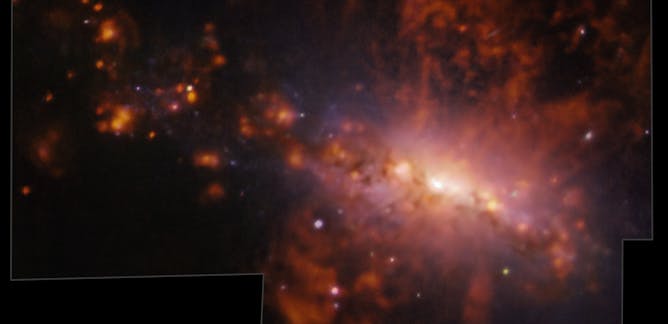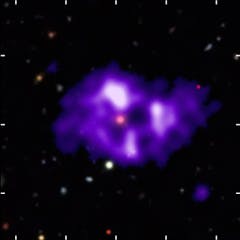
Articles on Galaxies
Displaying 1 - 20 of 104 articles

When astronomers focused on the galaxy NGC 4383, they didn’t expect the data to be so spectacular. This is the first detailed map of gas flowing from this galaxy as stars burst within.

An attempt to study gas in one galaxy with the MeerKAT radio telescope detected 49 other galaxies instead.

The discovery raises big questions about widely accepted models of galaxy formation.

People have been looking up at the stars for thousands of years. Here’s where to start if you want to learn more about the night sky – from spotting easy-to-find constellations to using the best apps.

Do all big black holes in very massive galaxies emit radio waves? We used the latest radio telescopes to find out.

New ASKAP images reveal a giant hydrogen ring around the spiral galaxy NGC 4632.

The universe used to be filled with a hydrogen fog, before early stars and galaxies burned through the haze. Astronomers are studying galaxies that tell them about this period in the early universe.

One of the few examples of a fast radio burst and the slow-moving, star forming gas in its origin galaxy has been linked together – thanks to observations from a CSIRO telescope.

Upgrades to the hardware and software of the advanced observatory should allow astrophysicists to detect much fainter gravitational waves than before.

Artificial intelligence tools are making waves in almost every aspect of life, and astronomy is no different. An astronomer explains the history and future of AI in understanding the universe.

Machine learning is becoming an indispensable tool in astronomy by sorting through enormous datasets from telescopes.

Astronomers have found that mysterious dark energy may originate in black holes.

While we can’t see inside a black hole, we can spot the intensely bright glowing disc that surrounds one. Now, we might better understand why these discs appear to ‘twinkle’.

It has been one year since the launch of the James Webb Space Telescope and six months since the first pictures were released. Astronomers are already learning unexpected things about the early universe.

A comparison of star-forming galaxies suggests, surprisingly, that dark matter and visible matter do interact – taking us closer to understanding what keeps the galaxies together.

James Webb has spotted extremely distant galaxies formed soon after the Big Bang, but are they old or young? Or is this the wrong question to ask?

Long before the James Webb telescope brought us these deep field images, artists have been capturing notions of space.

NASA released five new images from the James Webb Space Telescope, revealing incredible details of ancient galaxies, stars and the presence of water in the atmosphere of a distant planet.

Even experts were not prepared for the crispness of the new images from the James Webb space telescope.

Recent results cast doubt on dark matter.
